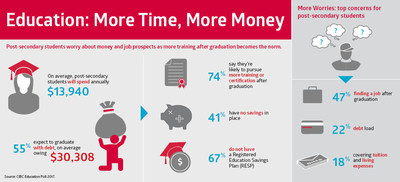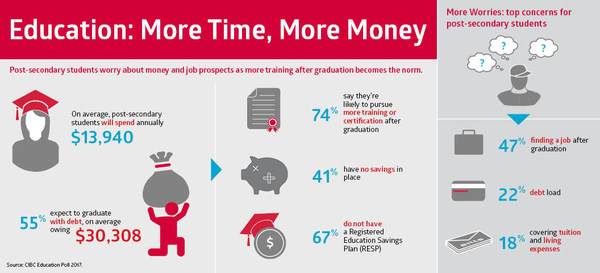Students head back to school worried about their job prospects, and expect to pursue more training after graduation
TORONTO, Aug. 31, 2017 /CNW/ - A new CIBC (CM:TSX) (CM:NYSE) poll finds that the majority (74 per cent) of Canadian post-secondary students believe they will need to supplement their schooling with more training after graduation, despite already spending on average $14,000 each year and expecting to owe $30,000 in debt by the time they complete their current program.

Despite the growing education bill, two-in-five (41 per cent) students have zero savings in place, and as many as two-thirds (67 per cent) don't have a registered education savings plan to help them.
"Students are telling us that they're worried about finding a well-paying job after graduation, and the need for more training and higher costs of some degrees is adding to the already high education bill," says David Nicholson, Vice-President, CIBC Imperial Service. "The key to success is having a detailed budget and financial plan that takes you from your schooling to your earning years. Parents can help by building savings early on, and helping students understand how to manage their money and borrow wisely."
Key poll findings:
- $13,940 is the average amount post-secondary students say they will spend annually on their education.
- More than half (55 per cent) say they will graduate with debt, owing $30,308 on average
- About a quarter (24 per cent) of students don't know how much they will spend per year and 27 per cent don't know how much money they will owe by the time they complete their education
- 74 per cent say they're likely to pursue additional training or certification after graduation
- 41 per cent have no savings in place to assist with the cost of education
- 67 per cent do not have a Registered Education Savings Plan (RESP)
With so few students reaping the benefit of RESPs, the back-to-school season is an important reminder for parents to open accounts for their children, says Mr. Nicholson.
"The big advantage to a RESP is the tax-free accumulation of savings combined with the added benefit of government grants," he says. "It's a powerful combination, and every little bit can add up to a significant amount over time to help with your child's education."
The long game in education is the 'new norm'
The poll finds that students are heading back to school worried about finding a job after graduation (47 per cent), their debt load (22 per cent), and covering tuition and living expenses (18 per cent).
The findings also reveal that students strongly or somewhat agree that:
- "taking a specialized program after graduation is the new norm – an undergraduate degree is not enough" (80 per cent);
- "getting a good job or gainful employment is the primary reason to pursue post-secondary education" (84 per cent); and
- They would "prefer an education/degree that includes job-specific skills, certification or vocational training rather than an academic degree alone" (82 per cent).
According to a recent CIBC Capital Markets report, students are becoming increasingly pragmatic about their career paths, choosing high-demand, higher-paying disciplines like business and science, technology, engineering and math (STEM). But, these options aren't cheap and costs are rising quickly.
In fact, the poll finds students enrolled in STEM sectors expect to owe roughly $43,000 by the time they graduate, compared with roughly $26,000 for non-STEM peers. Despite the higher debt load, STEM-students felt more confident in securing a well-paying job, compared with their non-STEM peers, 59 per cent versus 42 per cent. They also expect to earn significantly more than their peers, $59,256 versus $43,105.
"When it comes to mapping out an education today – and what it will all cost -- students really need to have their future in mind and plan for the long term," says Mr. Nicholson. "That's why it's more important than ever to figure out how your savings, debt and future earnings will work together to pay for it.
"Sometimes the best thing parents can do is help adult kids to stand on their own with some shared financial responsibility early on," he adds. "While we all want to help our kids as best we can, giving our kids some skin in the game can be a very good thing. It can teach kids how to set goals, budget, build credit and set themselves up for success for years to come."
Smart tips to keep education costs in check:
- Start saving early and regularly – every little bit helps
- Be clear about the total bill (tuition, books, meals, accommodation, and data/phone, etc.)
- Seek out ways to reduce your bill with scholarships, bursaries and grants, or special student offers
- Do your homework: Know your paths to employment and map out any additional education you'll need
- Talk to an expert to identify how best use savings and debt to meet your financial priorities
KEY POLL FINDINGS:
Amount that Canadian post-secondary students say they spend annually on student-related expenses (tuition, books, etc.) and personal expenses (rent, entertainment, etc.)
|
All |
Non-STEM |
STEM |
|
|
Average |
$13,940 |
$13,608 |
$14,763 |
|
Less than $5,000 |
18 % |
19 % |
18 % |
|
$5,001 - $10,000 |
20 % |
20 % |
22 % |
|
$10,001 - $20,000 |
23 % |
23 % |
24 % |
|
$20,001 - $30,000 |
10 % |
11 % |
9 % |
|
More than $30,000 |
4 % |
3 % |
6 % |
|
I don't know |
24 % |
25 % |
22 % |
Amount of debt that Canadian post-secondary students expect to owe when they complete their education:
|
All |
Non-STEM |
STEM |
|
|
Average |
$30,308 |
$25,510 |
$42,553 |
|
$0 |
18 % |
19 % |
16 % |
|
$10,000 or less |
14 % |
14 % |
13 % |
|
$10,0001 - $25,000 |
12 % |
13 % |
10 % |
|
$25,001 - $50,000 |
16 % |
16 % |
17 % |
|
$50,001 - $75,000 |
6 % |
6 % |
5 % |
|
More than $75,000 |
6 % |
4 % |
11 % |
|
I don't know |
27 % |
27 % |
27 % |
Canadian post-secondary students who have savings in place to assist with cost of education:
|
Registered Education Savings Plan (RESP) |
33 % |
|
Tax Free Savings Account (TFSA) |
27 % |
|
Other savings |
20 % |
|
None |
41 % |
Canadian post-secondary students who say they're likely to pursue additional training upon graduation or completion of their current program:
|
Very likely |
37 % |
|
Somewhat likely |
37 % |
|
Not likely |
11 % |
|
Not likely at all |
5 % |
|
I don't know |
10 % |
Top financial concerns of Canadian post-secondary students:
|
Finding a job or well-paying job in my field of study upon graduation |
47 % |
|
Being able to pay back my student loan(s)/debt and school related debt |
22 % |
|
Not having enough money for tuition and living expenses |
18 % |
|
Finding/keeping part-time employment throughout the school year |
6 % |
|
Having extra money for fun |
5 % |
|
Other |
2 % |
Canadian post-secondary students who expect to be able to attain well-paying full-time employment in their field of study after graduation:
|
All |
Non- |
STEM |
|
|
Yes |
47 % |
42 % |
59 % |
|
No |
15 % |
15 % |
13 % |
|
I don't know |
38 % |
43 % |
28 % |
Average of how Canadian post-secondary students say they cover their education costs on a percentage basis:
|
Myself, through jobs |
31 % |
|
Parents/other family |
25 % |
|
Scholarships, grants, bursaries |
14 % |
|
Government loan |
20 % |
|
Personal loan/line of credit |
6 % |
|
Other |
4 % |
About the CIBC Education Poll:
From July 27th to August 2nd, 2017 an online survey was conducted among 1,506 randomly selected Canadian adults who are currently enrolled as full or part time students and who are Angus Reid Forum, Peanut Labs or Precision Sample panellists. The margin of error—which measures sampling variability—is +/- 2.4%, 19 times out of 20. Discrepancies in or between totals are due to rounding.
About CIBC
CIBC is a leading Canadian-based global financial institution with 11 million personal banking, business, public sector and institutional clients. Across Personal and Small Business Banking, Commercial Banking and Wealth Management, and Capital Markets businesses, CIBC offers a full range of advice, solutions and services through its leading digital banking network, and locations across Canada, in the United States and around the world. Ongoing news releases and more information about CIBC can be found at www.cibc.com/ca/media-centre or by following on LinkedIn (www.linkedin.com/company/cibc), Twitter @CIBC, Facebook (www.facebook.com/CIBC) and Instagram @CIBCNow.
SOURCE CIBC






